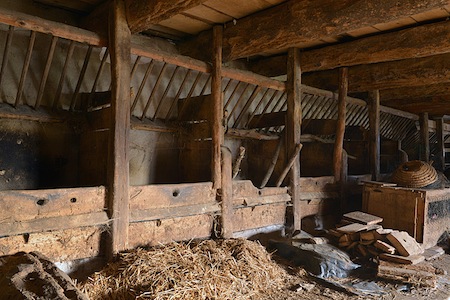Some people have been spreading the rumour they saw me dozing in my car with the engine idling to keep warm.
Liars. I had parked the car on the other side of the farm, completely out of sight. No one could have seen me.
“You are lucky to have hot water, we did not enjoy such a luxury during the war, so please don’t shame the family name. Neighbours are watching you”. That was my 85-year old mum over the phone. She had spent some of her teenage winters in the village just across the main road during the German occupation.

How did my forebears manage? This winter has been an El Niño winter combined with global warming. We’ve hardly had any snow. This has been the mildest winter not only on record but also in people’s living memory here. And yet, it feels bitterly cold in the house. How did they manage when it was freezing solid all day long for one straight month, or two?
I could not figure it out until I visited a relative in a neighbouring village.
So there we were in the cow shed, and it felt surprisingly warm. Even comfy. “How do you heat up the place?” I asked. “Grass”, he said. Grass? Ethanol maybe, I thought? No, there was no ethanol plant around here that I knew of, and in any case they would make it with a better crop than grass.
As he left me to puzzle out the mystery, I suddenly sensed I had already felt this kind of warmth more than thirty years ago. That was on rugby fields in a bygone era, when it was still common to have a 30-man pile-up, technically called a “maul”, before the whistle blew. What I sensed was familiar was this kind of … well, mammalian warmth. Mammals… cows… grass… That was the secret. Cows were grass-fed heat generators!

Back on the internet, numbers started to roll like a winning lottery. Cows can generate from a mere 3,500 BTU (British Thermal Units) per hour, to a whopping 6,300. This is from 1 kW to almost 2 kW.
Hence, on average, a cow is a 1.5 kW heat generator. If you have a 10-head herd, then you have 15 kW available for heating. Every day and night, every hour, every minute. These ladies don’t go for coffee breaks.
I thought I was smart with my 13 kW “peak” power solar cells plan – “peak” actually meaning once in a blue moon, at noon right in the middle of summer. The engineer told me that, in the midst of winter, the cells would actually only deliver around 18 kWh a day, equivalent to a 0.75-kW generator working 24 hours. Yes, half a cow actually. I can’t compete, can I? 
15 kW. Forget about the milk, the leather and the meat. And you know what? These ladies are renewable and 100% recyclable. Fully COP21-compliant. And we are not even talking biomass generation…
So I asked my neighbour if he could lend me 10 heads, since I still had the barn ready for business. “No problem” he said, “you just have to feed each of them with 50 kgs of grass silage and 100 litres of water every single day. And don’t forget to milk them twice a day, otherwise things may get a bit out of control. And when a cow gives birth, just do what your instinct tells you to do. Oh, last but not least, remember to clean the … biomass”. Is that all?
This is the only issue with cows actually: they don’t come with the handy on-off switch that would allow you to peacefully read the BBC with your morning coffee.

